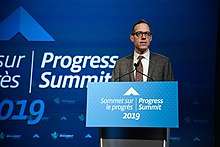Rick Smith (environmentalist)
Rick Smith (born 1968) is a Canadian author, environmentalist and non-profit leader. He is currently the Executive Director of the Broadbent Institute.[1] Smith became Executive Director in 2012.
Rick Smith | |
|---|---|
 Smith in 2019 | |
| Born | 1968 (age 52) |
| Occupation | Executive Director, Broadbent Institute |
Early Life and Education
Smith was born in Montreal, Quebec, and attended high school in Richmond Hill, Ontario.
He received his Ph.D. in biology in 1999 from the University of Guelph. His research, completed in cooperation with the Cree community of Whapmagoostui, in Nunavik, northern Quebec, focused on a unique population of freshwater harbor seal. Smith's work led to the population's listing as “endangered” under Canada's Species At Risk Act and IUCN Red List of Threatened Species.[2] The need for enhanced protection of this population was one of the key factors in the creation of Tusujuq National Park – the largest protected area in eastern North America – in 2012.[3]
Career
From 1996 to 2002, Smith was Executive Director of the International Fund for Animal Welfare’s (IFAW) Canadian office and a leader in the campaign to create Canada's federal Species At Risk Act.[4] In 2001, he was simultaneously IFAW's UK Director and led the organization's efforts in the UK and EU parliaments.
In 2003, Smith became Jack Layton’s first Chief of Staff upon Layton's election as leader of the federal New Democratic Party. He resigned over controversy within the party related to his previous environmental work.[5]
As Executive Director of Environmental Defence Canada between 2003 and 2012, Smith was an early proponent of an environmentalism rooted in new, sustainable, economic models. He was a key proponent of the Ontario Greenbelt and the Ontario Green Energy Act and a founding Director of the Greenbelt Foundation.[6][7] Smith led the efforts to create Canada’s modernized Consumer Product Safety Act and Chemicals Management Plan, which resulted in Canada becoming the first nation in the world to ban bisphenol A in children's products.[8][9][10] With the United Steelworkers, he founded Blue Green Canada, the first permanent partnership between trade unions and environmental organizations in the country.[11] He was instrumental in the establishment of the Socially and Environmentally Responsible Aggregate (SERA) initiative, the world’s first independently-certified sustainability standard for the global aggregate and concrete industry. Smith was one of the founders of the Strathmere Group.[12]
Since 2013, Smith has been Executive Director of the Broadbent Institute.[13] Under his leadership, the Institute has become Canada’s pre-eminent progressive policy and training organization with offices in Montreal, Toronto, Ottawa and Vancouver.[14] The Institute’s media project, PressProgress, is now Canada’s most-shared source of progressive news and analysis.[15] Smith is also an advisor to Progress Toronto.[16] The Broadbent Institute is the Canadian affiliate of the Foundation for European Progressive Studies (FEPS).[17]
Books
Smith co-authored “Slow Death by Rubber Duck: How the Toxicity of Everyday Life Affects Our Health” (2009, Knopf Canada, re-issued 2019, Knopf Canada) and “Toxin Toxout: Getting Harmful Chemicals Out of Our Bodies and Our World” (2013, Knopf Canada in Canada; St. Martin's Press in the U.S.) A Quill & Quire “Book of the Year” for 2009, “Slow Death by Rubber Duck” has been translated into seven languages, featured at the Sydney Writers’ Festival, and by the Washington Post ( “hard-hitting in a way that turns your stomach and yet also instills hope”), Dr. Oz, Fox News, and Oprah Magazine.[18] In their two books, Smith and his co-author, prominent Canadian environmental expert Bruce Lourie, experiment on their own bodies, raising and lowering levels of toxic chemicals in their blood and urine through the performance of common activities. Their new experimentation in the 2019 re-issue of “Slow Death by Rubber Duck” has sparked a renewed debate on the presence of bisphenol A in consumer items.[19]
Personal
Smith currently lives in east-end Toronto with his wife Jennifer Story – a Toronto District School Board Trustee – and their two children.[20]
References
- "Broadbent Institute | Team". Broadbent Institute. Retrieved 2019-09-09.
- Canada, Environment and Climate Change (2009-09-15). "Harbour seal (Phoca vitulina) COSEWIC assessment and status report". aem. Retrieved 2019-11-04.
- News, Nunatsiaq (2012-12-17). "Quebec moves ahead on Nunavik's Tursujuq provincial park". Nunatsiaq News. Retrieved 2019-09-09.
- "Nature.com". Retrieved 2019-09-09.
- "Building the Orange Wave". Retrieved 2019-09-09.
- "No more tightening the Greenbelt | The Star". thestar.com. Retrieved 2019-09-09.
- "Greenbelt.ca".
- "New consumer safety law gives Ottawa powers to recall unsafe toys, cribs | Globalnews.ca". globalnews.ca. 2011-06-20. Retrieved 2019-09-09.
- "Canada praised for regulation of toxic chemicals". Retrieved 2019-09-09.
- "Canada takes steps back to ban most plastic baby bottles". Retrieved 2019-09-09.
- Blue Green Canada launch April 2009, retrieved 2019-09-09
- "The Strathmere group presents inaugural Environmental Leadership Award". McConnell Foundation. 2010-10-26. Retrieved 2019-09-09.
- "The Strathmere group presents inaugural Environmental Leadership Award". McConnell Foundation. 2010-10-26. Retrieved 2019-09-09.
- "About the Institute". Broadbent Institute. Retrieved 2019-09-09.
- Pressprogress. "About Us". PressProgress. Retrieved 2019-09-09.
- "Rick Smith". Progress Toronto. Retrieved 2019-09-09.
- "Home - Foundation for European Progressive Studies (FEPS)". www.feps-europe.eu. Retrieved 2019-09-09.
- "Slow Death by Rubber Duck – How the Toxic Chemistry of Everyday Life Affects Our Health". Retrieved 2019-09-09.
- "Receipts expose retail workers, consumers to 'worrying' levels of cancer-linked chemicals: study | CTV News". www.ctvnews.ca. Retrieved 2019-09-09.
- "Rick Smith". Broadbent Institute. Retrieved 2019-09-09.